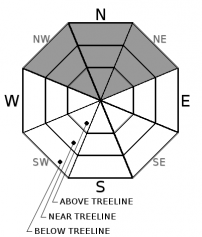| Tuesday | Tuesday Night | Wednesday | |
|---|---|---|---|
| Weather: | Mostly cloudy with a chance of snow in the morning. Clouds increasing during the day and snow and rain in the afternoon. | Snow and rain in the evening. Snow and rain decreasing after midnight. | Cloudy with a chance of snow and rain in the morning becoming mostly cloudy with a slight chance of rain and snow in the afternoon. |
| Temperatures: | 34 to 40 deg. F. | 30 to 35 deg. F. | 43 to 49 deg. F. |
| Mid Slope Winds: | Southwest | Southwest | Southwest |
| Wind Speed: | 10 to 15 mph with gusts to 35 mph increasing to gusts to 45 mph in the afternoon | 15 to 25 mph with gusts to 45 mph | 20 to 30 mph with gusts to 55 mph increasing to 70 mph in the afternoon |
| Expected snowfall: | up to 2 | 2 to 6 | up to 1 |
| Tuesday | Tuesday Night | Wednesday | |
|---|---|---|---|
| Weather: | Mostly cloudy with a chance of snow in the morning. Clouds increasing during the day and snow in the afternoon. | Snow in the evening, becoming snow and rain after midnight and decreasing. | Cloudy with a chance of snow and rain in the morning becoming mostly cloudy with a slight chance of rain and snow in the afternoon. |
| Temperatures: | 32 to 38 deg. F. | 28 to 33 deg. F. | 36 to 42 deg. F. |
| Ridge Top Winds: | Southwest | Southwest | Southwest |
| Wind Speed: | 20 to 30 mph with gusts to 60 mph increasing to gusts to 75 mph in the afternoon | 20 to 35 mph with gusts to 75 mph increasing to gusts to 85 mph after midnight | 30 to 50 mph with gusts to 90 mph increasing to gusts to 105 mph in the afternoon. |
| Expected snowfall: | 1 to 2 | 3 to 6 | up to 1 |























